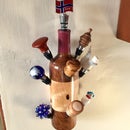Introduction: How to Polish and Clean Cymbals
If you are a drummer, you know just how important your cymbals are. Cymbal care is underestimated in its importance to the sound and life-span of your cymbals. Not cleaning a cymbal is just asking for trouble. Color changing, rust, cracking are all results of poor cymbal care. Its like not brushing your teeth.
When there weren't any specialized products for cleaning cymbals, drummers had to settle for using brass polish. Even though we've come along way since then, people are still using brass polish for cymbal care. There are a lot of products out there for polishing and cleaning cymbals, so lets discuss.
Also check out some of my other drum instructables:
Drum Tuning
Cymbal Repair
Effects Snare Drum
When there weren't any specialized products for cleaning cymbals, drummers had to settle for using brass polish. Even though we've come along way since then, people are still using brass polish for cymbal care. There are a lot of products out there for polishing and cleaning cymbals, so lets discuss.
Also check out some of my other drum instructables:
Drum Tuning
Cymbal Repair
Effects Snare Drum
Step 1: Buff-on Cymbal and Brash Polishing
Many Cymbal companies such as Zildjian, Sabian and Paiste make and sell their own brand of cymbal polish. Although they recommend that you use this polish on their cymbals, you can use just about any kind of brass polish on your cymbals. There are some important things to consider here:
My main problem with most brass and cymbal polishes is that they only account for the brass component of the cymbal. While this is the main metal used to make cymbals, many cymbals (especially the nicer ones) have at least 15% tin and/or bronze, and in some cases it can be higher. In addition the buffing process is no joke, and if you really want your cymbals to shine, you have no choice but to wear your arm off trying to get results. In the end, it usually ends up looking like the cymbal here, which leaves much to be desired. Don't fret though, keep reading.
- Abrasive Polishes
- Everyone is an Expert
My main problem with most brass and cymbal polishes is that they only account for the brass component of the cymbal. While this is the main metal used to make cymbals, many cymbals (especially the nicer ones) have at least 15% tin and/or bronze, and in some cases it can be higher. In addition the buffing process is no joke, and if you really want your cymbals to shine, you have no choice but to wear your arm off trying to get results. In the end, it usually ends up looking like the cymbal here, which leaves much to be desired. Don't fret though, keep reading.
Step 2: Best Kept Secret
I gotta say, the first handful of times that I attempted to polish my cymbals I became really disconcerted. It is no walk in the park and more than half the time they ended up looking just as bad (in a different way) as before. About two years ago I was working in the drum shop of a Guitar Center when I discovered a new product we had. After a couple of test runs, we started using it to clean all of the cymbals in the drum shop. Made by Pro Mark, Groove Juice will end up saving you time, money and a whole lot of effort.
Basically, rather than having to go through the whole buffing process, the steps couldnt be easier. Groove Juice only requires you to spray it on the cymbal, let it sit for between 30 seconds to a minute, then wipe it off. At this point, it would be smart to go back over the cymbal with a wet cloth since the GJ is acidic. Nevertheless, you end up spending a fraction of the time dealing with this process, and your results will be awesome.
One thing to realize is that Groove Juice is a cleaner, not a polish. One of the reasons that many people have trouble polishing their cymbals is that if you have a dirty cymbal to begin with, rubbing polish all over the cymbal isnt going to remove the dirt and oil. You can still polish your cymbals after they've been cleaned, but you wont really need to. Using this cleaner will make your cymbals shine like mirrors.
One other thing to mention... you can also clean your drum hardware with Groove Juice. Same method, just spray, wait and wipe. Its as easy as it sounds, and a bottle only costs like 7 bucks. Do yourself a favor and avoid the pain of brass polish.
Basically, rather than having to go through the whole buffing process, the steps couldnt be easier. Groove Juice only requires you to spray it on the cymbal, let it sit for between 30 seconds to a minute, then wipe it off. At this point, it would be smart to go back over the cymbal with a wet cloth since the GJ is acidic. Nevertheless, you end up spending a fraction of the time dealing with this process, and your results will be awesome.
One thing to realize is that Groove Juice is a cleaner, not a polish. One of the reasons that many people have trouble polishing their cymbals is that if you have a dirty cymbal to begin with, rubbing polish all over the cymbal isnt going to remove the dirt and oil. You can still polish your cymbals after they've been cleaned, but you wont really need to. Using this cleaner will make your cymbals shine like mirrors.
One other thing to mention... you can also clean your drum hardware with Groove Juice. Same method, just spray, wait and wipe. Its as easy as it sounds, and a bottle only costs like 7 bucks. Do yourself a favor and avoid the pain of brass polish.











